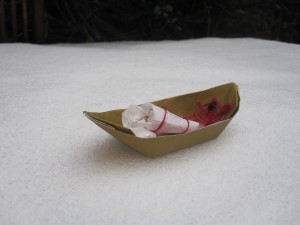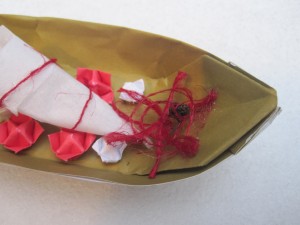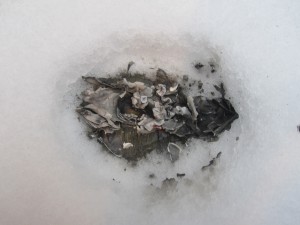I’ve been neglecting the blog of late, for reasons too dreary to explain. So I am taking the astonishingly original step of racking up a load of pretty pictures of organisms to release on a semi-regular basis. I am creativity incarnate.
Today, +Laburnocytisus ‘Adamii’.
![+Laburnocytisus adamii [CC-BY-2.0 Alex Lomas]](http://www.polypompholyx.com/wp-content/uploads/2013/01/+Laburnocytisus_adamii-199x300.jpg)
+Laburnocytisus ‘Adamii‘
Technically, this is a bit of a cheat for an organism of the week, as this organism is technically two organisms, one growing inside of the other.
This pretty mess is the result of a horticultural grafting going wrong. In a normal grafting, a bud from one plant (the scion) is inserted into a cleft cut into the stem of another (the rootstock). If the grafting behaves itself, you will then end up with the branches and fruit of one tree growing on the roots and trunk of another. Grafting is crucial in the farming of apples. If you plant the seeds from a nice apple, like an Egremont Russet, the resulting trees will take many years to get large enough to produce what will almost certainly be terribly disappointing fruit: most cultivated species of apple do not come true from their seed. Instead they have to be propagated vegetatively, and this is where grafting comes in. By grafting scions from an Egremont Russet onto a mass-produced rootstock (whose fruit you care not one jot about, but which has fabulous dwarfing roots), you can have an productive orchard making pleasant fruits within a few years, rather than the decades and more that would be needed to create a(n un)lucky-dip orchard from seed.
Grafting works best between closely related species. When it doesn’t work properly, the usual result is a dead scion. However, sometimes grafting goes just a bit wrong, and that is what has happened with +Laburnocytisus. Rather than having a scion growing on a rootstock separated by a scar, the scion and rootstock tissues have become mixed up in the scar, and are attempting to grow together. These somewhat unhappy marriages are called graft chimaeras.
The core tissue of +Laburnocytisus is Laburnum anagyroides, a popular child-killing shrub, which goes by the common name of ‘golden showers’ (*titters*). Growing over this core is a skin of tissue from another member of the bean family, the purple broom (Chamaecytisus purpureus).
Laburnum and broom are closely related, so for the most part, the two tissues manage to communicate their intentions quite well, and the leaves and flowers they produce are intermediate between the two species. But sometimes the laburnum core grows more quickly than the broom skin, and a chunk of laburnum bursts out in a shower of golden flowers, as you can see in the photo above.

![pGLO contamination [CC-BY-SA-3.0 Steve Cook]](http://www.polypompholyx.com/wp-content/uploads/2013/02/pGLO_contamination_fun-300x224.jpg)
![Drosophyllum lusitanicum [CC-BY-2.0 Alex Lomas] Drosophyllum lusitanicum [CC-BY-2.0 Alex Lomas]](http://www.polypompholyx.com/wp-content/uploads/2013/01/Drosophyllum_lusitanicum-199x300.jpg)
![Amanita muscaria [CC-BY-SA-3.0 Steve Cook]](http://www.polypompholyx.com/wp-content/uploads/2013/01/Amanita_muscaria-225x300.jpg)
![Halobacterium salinarum [CC-By-SA-3.0 Steve Cook]](http://www.polypompholyx.com/wp-content/uploads/2013/01/Halobacterium_salinarum-225x300.jpg)
![Butterwort collection [CC-BY-SA-3.0 Steve Cook] Butterwort collection [CC-BY-SA-3.0 Steve Cook]](http://www.polypompholyx.com/wp-content/uploads/2013/01/butterwort_collection-300x104.jpg)
![Pinguicula cv. Tina flowers [CC-BY-SA-3.0 Steve Cook] Pinguicula cv. Tina flowers [CC-BY-SA-3.0 Steve Cook]](http://www.polypompholyx.com/wp-content/uploads/2013/01/Pinguicula_cv._Tina_flowers-224x300.jpg)
![Pinguicula esseriana flowers [CC-BY-SA-3.0 Steve Cook] Pinguicula esseriana flowers [CC-BY-SA-3.0 Steve Cook]](http://www.polypompholyx.com/wp-content/uploads/2013/01/Pinguicula_esseriana_flowers-274x300.jpg)
![Pinguicula cyclosecta winter rosette [CC-BY-SA-3.0 Steve Cook] Pinguicula cyclosecta winter rosette [CC-BY-SA-3.0 Steve Cook]](http://www.polypompholyx.com/wp-content/uploads/2013/01/Pinguicula_cyclosecta_winter_rosette-265x300.jpg)
![Instant Hipstagrammatic [CC-BY-SA-3.0 Mark Zuckerberg, I mean Steve Cook]](http://www.polypompholyx.com/wp-content/uploads/2013/01/mogrified-224x300.jpg)




![Phycomyces blakesleeanus [CC-BY-SA-3.0 Steve Cook]](http://www.polypompholyx.com/wp-content/uploads/2013/01/Phycomyces_blakesleeanus-300x224.jpg)
![+Laburnocytisus adamii [CC-BY-2.0 Alex Lomas]](http://www.polypompholyx.com/wp-content/uploads/2013/01/+Laburnocytisus_adamii-199x300.jpg)